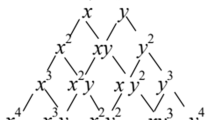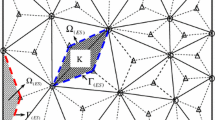Abstract
Free and forced vibration analysis is significant in structural mechanics and engineering. A sub-domain smoothed Galerkin method is developed for free and forced vibration analyses of 2D solids. This method integrates the advantages of mesh-free Galerkin method and finite element method (FEM). The arbitrarily shaped sub-domains are predefined in the problems domain represented by mesh-free nodes. In each sub-domain, based on mesh-free Galerkin weak formulation, the local discrete equation can be obtained by using moving kriging interpolation, which is similar to the discrete equation of a high-order element in FEM. The strain smoothing technique can be subsequently applied to the nodal integration of sub-domain by dividing the sub-domain into several smoothing cells. Moreover, condensation of degrees of freedom can also be introduced into discrete equations by transfer equations of inner nodes to equations of boundary nodes based on sub-domains. The global dynamic equations of the present method are obtained based on the scheme of FEM by assembling all local discrete equations of sub-domains and are solved by using the standard implicit Newmark’s time integration scheme. Numerical examples proved that the sub-domain smoothed Galerkin method is a robust technique to simulation the elastic dynamic problems, which has high computational efficiency and good accuracy.





















Similar content being viewed by others
References
Hughes T (1987) The finite element method—linear static and dynamic finite element analysis. Prentice Hall, Englewood Cliffs
Bathe KJ (1996) Finite element procedures. Prentice Hall, Englewood Cliffs
Liu GR, Dai KY, Nguyen-Thoi T (2007) A smoothed finite element method for mechanics problems. Comput Mech 39:859–877
Liu GR, Nguyen TT, Dai KY, Lam KY (2007) Theoretical aspects of the smoothed finite element method (SFEM). Int J Numer Methods Eng 71:902–930
Liu GR (2008) A generalized gradient smoothing technique and the smoothed bilinear form for Galerkin formulation of a wide class of computational methods. Int J Comput Methods 5(2):199–236
Krongauz Y, Belytschko T (1997) Consistent pseudo-derivatives in meshless methods. Int J Numer Methods Eng 146:371–386
Chen JS, Wu CT (2001) A stabilized conforming nodal integration for Galerkin mesh-free method. Int J Numer Methods Eng 50:435–466
Chen JS, Wu CT (1998) Generalized nonlocal mesh-free method in strain localization. In: Proceeding of international conference on computational engineering science, Atlanta, Georgia, 6-9 October 1998
Chen JS, Wu CT, Belytschko T (2000) Regularization of material instabilities by mesh-free approximations with intrinsic length scales. Int J Numer Methods Eng 47:1303–1322
Beissel S, Belytschko T (1996) Nodal integration of the element-free Galerkin method. Comput Methods Appl Mech Eng 139:49–74
Bonet J, Kulasegaram S (1999) Correction and stabilization of smooth particle hydrodynamics methods with applications in metal forming simulation. Int J Numer Methods Eng 47:1189–1214
Dai KY, Liu GR, Nguyen TT (2007) An n-sided polygonal smoothed finite element method (nSFEM) for solid mechanics. Finite Elem Anal Des 43:847–860
Cui XY, Liu GR, Li GY, Zhao X, Nguyen TT, Sun GY (2008) A smoothed finite element method (SFEM) for linear and geometrically nonlinear analysis of plates and shells. Comput Model Eng Sci 28(2):109–126
Nguyen-Xuan H, Rabczuk T, Bordas S, Debongnie JF (2008) A smoothed finite element method for plate analysis. Comput Methods Appl Mech Eng 197:1184–1203
Liu GR, Nguyen-Thoi T, Lam KY (2009) An edge-based smoothed finite element method (ES-FEM) for static, free and forced vibration analyses of solids. J Sound Vib 320(4):1100–1130
Dai KY, Liu GR (2007) Free and forced vibration analysis using the smoothed finite element method (SFEM). J Sound Vib 301(3):803–820
Nguyen-Thoi T et al (2009) A face-based smoothed finite element method (FS-FEM) for 3D linear and geometrically non-linear solid mechanics problems using 4-node tetrahedral elements. Int J Numer Methods Eng 78(3):324–353
Tran TN et al (2010) An edge-based smoothed finite element method for primal–dual shakedown analysis of structures. Int J Numer Methods Eng 82(7):917–938
Liu GR et al (2009) A node-based smoothed finite element method (NS-FEM) for upper bound solutions to solid mechanics problems. Comput Struct 87(1):14–26
Liu GR (2010) A G space theory and a weakened weak (W2) form for a unified formulation of compatible and incompatible methods: part I theory. Int J Numer Methods Eng 81:1093–1126
Belytschko T, Krongauz Y, Organ D, Fleming M, Krysl P (1996) Meshless methods: an overview and recent developments. Comput Methods Appl Mech Eng 139:3–47
Belytschko T, Tabbara M (1996) Dynamic fracture using element-free Galerkin methods. Int J Numer Methods Eng 39(6):923–938
Liu L, Liu GR, Tan VBC (2002) Element free method for static and free vibration analysis of spatial thin shell structures. Comput Methods Appl Mech Eng 191(51):5923–5942
Bui TQ, Nguyen TN, Nguyen-Dang H (2009) A moving kriging interpolation-based meshless method for numerical simulation of Kirchhoff plate problems. Int J Numer Methods Eng 77:1371–1395
Bui TQ, Nguyen TN (2011) A moving kriging interpolation-based mesh-free method for free vibration analysis of Kirchhoff plates. Comput Struct 89(3–4):380–394
Bui TQ, Nguyen TN, Zhang CZ (2011) A moving kriging interpolation-based element-free Galerkin method for structural dynamic analysis. Comput Methods Appl Mech Eng 200:1354–1366
Lam KY, Wang QX, Li H (2004) A novel meshless approach—local kriging (LoKriging) method with two-dimensional structural analysis. Comput Mech 33:235–244
Li H, Wang QX, Lam KY (2004) Development of a novel meshless local kriging (LoKriging) method for structural dynamic analysis. Comput Methods Appl Mech Eng 193:2599–2619
Gu YT, Liu GR (2001) A local point interpolation method for static and dynamic analysis of thin beams. Comput Methods Appl Mech Eng 190:5515–5528
Gu YT, Liu GR (2001) A meshless local Petrov-Galerkin (MLPG) formulation for static and free vibration analyses of thin plates. Comput Model Eng Sci 2(4):463–476
Gu YT, Liu GR (2001) A meshless local Petrov-Galerkin (MLPG) method for free and forced vibration analyses for solids. Comput Mech 27(3):188–198
Liu GR, Zhang GY, Gu YT et al (2005) A meshfree radial point interpolation method (RPIM) for three-dimensional solids. Comput Mech 36(6):421–430
Liu GR, Gu YT (2001) A local radial point interpolation method (LR-PIM) for free vibration analyses of 2-D solids. J Sound Vib 246(1):29–46
Zhou JX, Zhang HY, Zhang L (2005) Reproducing kernel particle method for free and forced vibration analysis. J Sound Vib 279(1):389–402
Wang L (2013) Convex meshfree solutions for arbitrary waveguide analysis in electromagnetic problems. Prog Electromagn Res B 48:131–149
Hu D, Wang Y, Liu GR, Li T, Han X, Gu YT (2014) A sub-domain smoothed Galerkin method for solid mechanics problems. Int J Numer Methods Eng 98:781–798
Gu L (2003) Moving kriging interpolation and element-free Galerkin method. Int J Numer Methods Eng 56:1–11
Sastry CVC, Mahapatra DR, Sopalakrishnan S, Ramamurthy TS (2003) An iterative system equivalent reduction expansion process for extraction of high frequency response from reduced order finite element model. Comput Methods Appl Mech Eng 192(15):1821–1840
Song C (2004) A super-element for crack analysis in the time domain. Int J Numer Methods Eng 61(8):1332–1357
Wu CT, Guo Y, Askari E (2013) Numerical modeling of composite solids using an immersed meshfree Galerkin method. Compos Part B 45:1397–1413
Choi D, Kim H, Cho M (2008) Iterative method for dynamic condensation combined with substructuring scheme. J Sound Vib 317(1–2):199–218
Belytschko T, Hughes T (1982) Computational methods for transient analysis, vol 1. North-Holland, Amsterdam
Smith IM, Griffiths DV (1998) Programming the finite element method, 3rd edn. Wiley, New York
Callahan JCO, Avitable P, Riemer R (1989) System equivalent reduction expansion process (SEREP). In: Proceedings of the 7th international modal analysis conference, (Las Vegas, Neveda), Union College, Schenectady, NY 1989, pp 29–37
Acknowledgments
Financial supports from National Natural Science Foundation of China (11102065, 11272118) and ARC Future Fellowship project of Australia (FT100100172) are gratefully acknowledged.
Author information
Authors and Affiliations
Corresponding author
Rights and permissions
About this article
Cite this article
Wang, Y., Hu, D., Yang, G. et al. An effective sub-domain smoothed Galerkin method for free and forced vibration analysis. Meccanica 50, 1285–1301 (2015). https://doi.org/10.1007/s11012-014-0088-6
Received:
Accepted:
Published:
Issue Date:
DOI: https://doi.org/10.1007/s11012-014-0088-6




